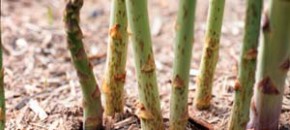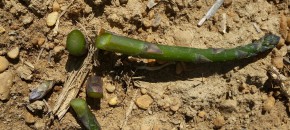Late blight has been reported in Florida and South Carolina on tomato. To track the season-long progress of Late blight in the US please visit (http://usablight.org/) There has been isolated reports of cucurbit downy mildew on watermelon and cucumber in southern Florida. To track the season-long progress of cucurbit downy mildew in the US please visit (http://cdm.ipmpipe.org/)
Continue reading...Controlling Purple Spot in Asparagus

Purple spot, caused the soil-borne fungus, Stemphylium vesicarium, can cause problems during cool, wet spring weather. Symptoms, just like its name, include numerous, sunken oval-shaped spots on spears during the harvest season and more importantly on ferns and stalks during the summer months as long as conditions are ideal for its development. Often, purple spot […]
Continue reading...Cold Injury: Disease Control in Peach Orchards without Fruit
Cold injury to peach flowers and primordial fruit occurred during the evening of April 5-6 as temperatures dropped below freezing. At the Rutgers Agricultural Research and Extension Center, air temperatures first dropped below 32ºF at 10 pm Tuesday and remained below freezing until 9 am Wednesday morning. The lowest temperatures of 22 to 23 ºF […]
Continue reading...Spear Damage in Asparagus

Spear damage in asparagus can be caused by diseases such as Phytophthora spear and crown rot and purple spot. However, other environmental factors during the spring can damage spears as they emerge from the soil. Freeze Injury – About 10 days ago temperatures dipped well below freezing for a night or two, and combined with the higher than […]
Continue reading...Organic Production: Suppressing Soil-borne Pathogens
Pathogens such as Fusarium, Pythium, Phytophthora, Thielaviopsis and Rhizoctonia that cause pre- and post-emergent damping-off can cause serious problems in organic (and conventional) transplant production. The key to controlling and/or suppressing damping-off pathogens with biological controls is keeping the biological populations high and continually present on root surfaces of the host, and by following good […]
Continue reading...Understanding Damping-off Pathogens in Transplant Production
Damping-off is caused by a number of important vegetable pathogens and is very common during transplant production and early-spring. Damping-off can kill seedlings before they break the soil line (pre-emergent damping-off) or kill seedlings soon after they emerge (post-emergent damping-off). Common pathogens that cause damping-off include Pythium, Phytophthora, Rhizoctonia and Fusarium spp. It is extremely […]
Continue reading...